Library Records Database Plan and Entity Relationship Diagram
VerifiedAdded on 2023/04/21
|6
|876
|349
Report
AI Summary
This report provides a detailed database plan for managing library records. It outlines the data requirements, including entities such as Employee, Customers, Branch, Books, Issue Status, and Return Status. Each entity is defined with specific attributes like employee name, ID, address, branch details, customer information, book details, and issue/return statuses. The report also describes the relationships between these entities, such as a manager managing a branch, customers registering in a branch, and customers issuing and returning books. An entity-relationship diagram is included to visually represent the database's logical structure, facilitating efficient data storage and retrieval. The report concludes with a discussion on the use and effectiveness of keywords like ISBN number and account number for information retrieval.
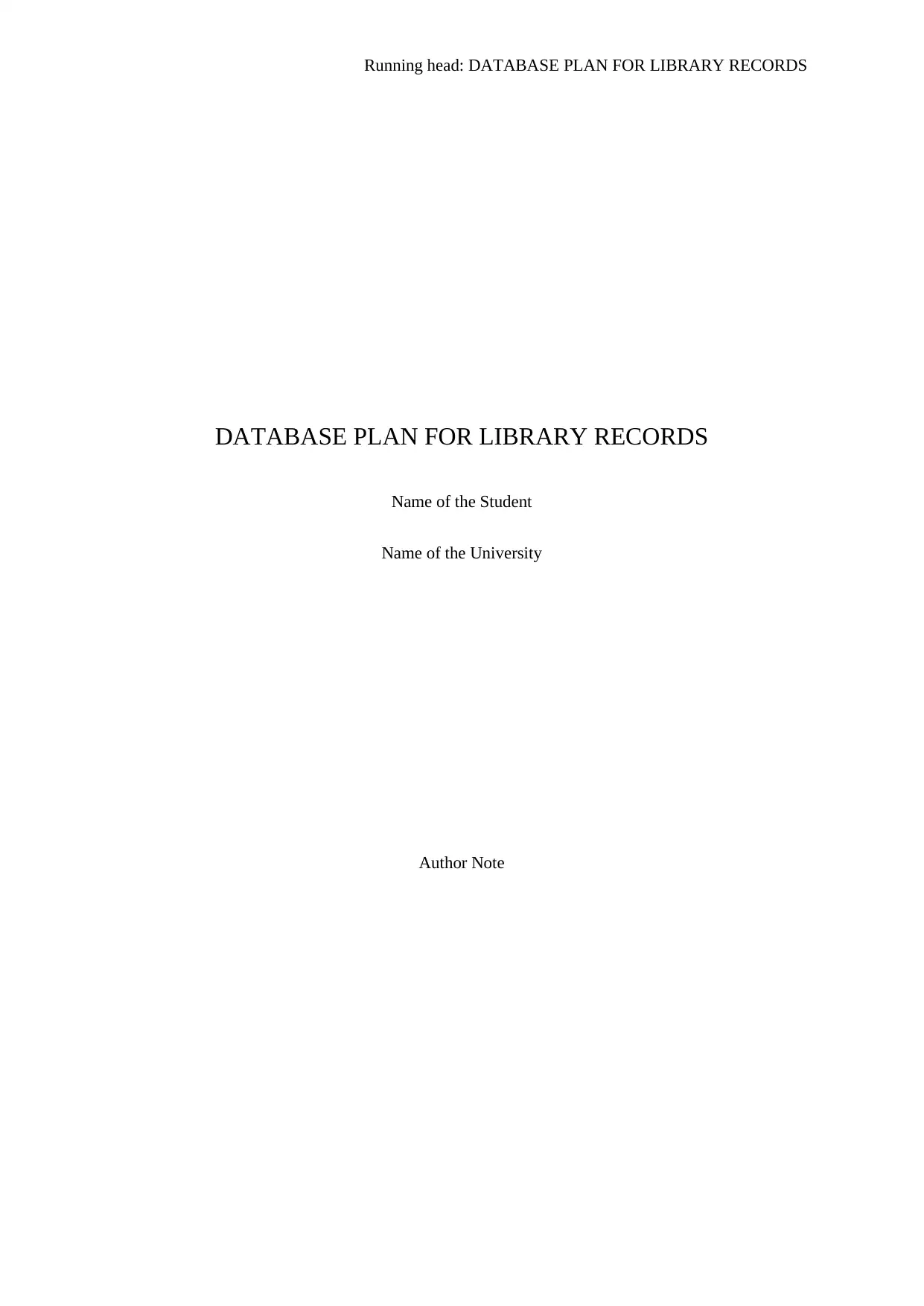
Running head: DATABASE PLAN FOR LIBRARY RECORDS
DATABASE PLAN FOR LIBRARY RECORDS
Name of the Student
Name of the University
Author Note
DATABASE PLAN FOR LIBRARY RECORDS
Name of the Student
Name of the University
Author Note
Paraphrase This Document
Need a fresh take? Get an instant paraphrase of this document with our AI Paraphraser
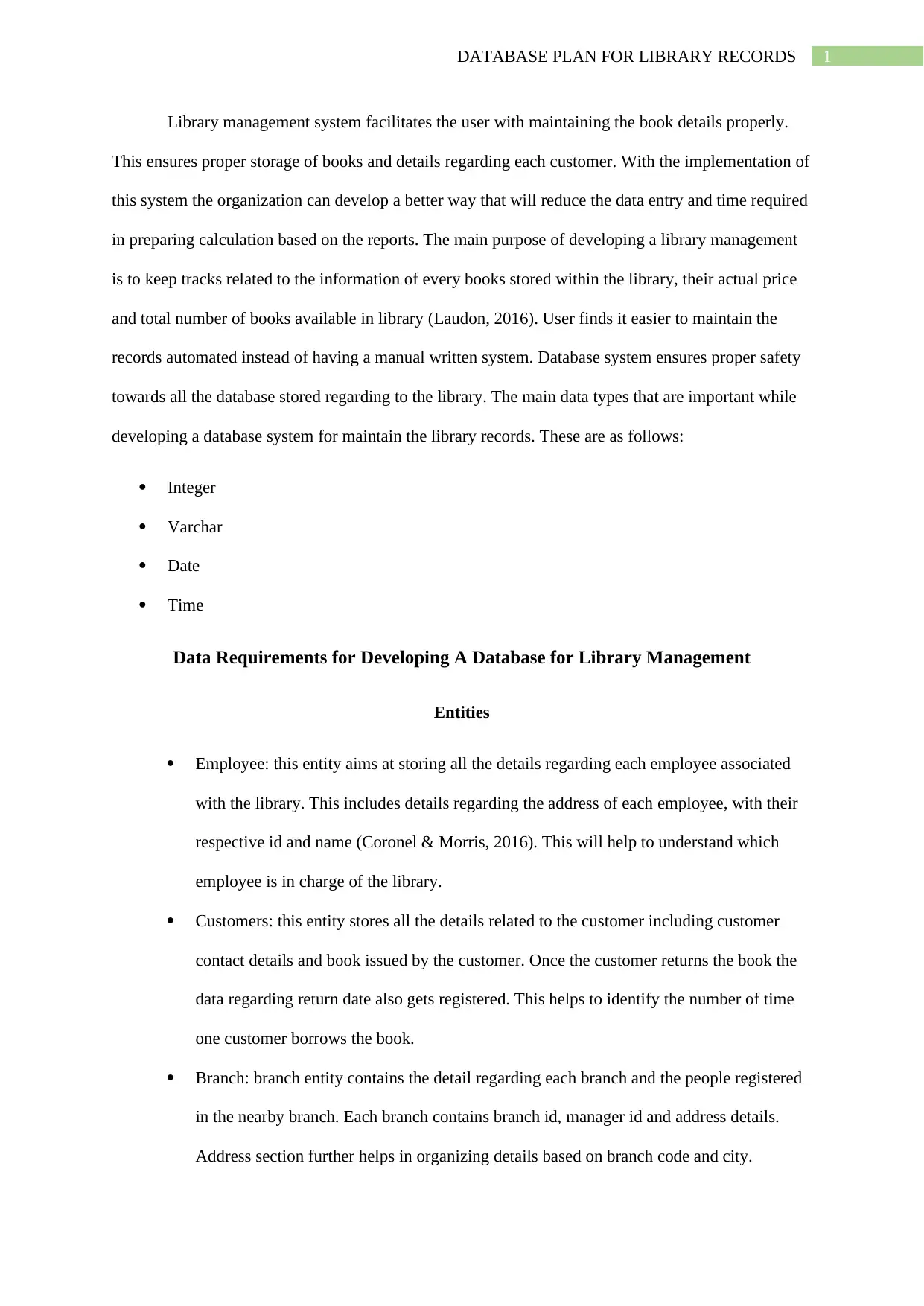
1DATABASE PLAN FOR LIBRARY RECORDS
Library management system facilitates the user with maintaining the book details properly.
This ensures proper storage of books and details regarding each customer. With the implementation of
this system the organization can develop a better way that will reduce the data entry and time required
in preparing calculation based on the reports. The main purpose of developing a library management
is to keep tracks related to the information of every books stored within the library, their actual price
and total number of books available in library (Laudon, 2016). User finds it easier to maintain the
records automated instead of having a manual written system. Database system ensures proper safety
towards all the database stored regarding to the library. The main data types that are important while
developing a database system for maintain the library records. These are as follows:
Integer
Varchar
Date
Time
Data Requirements for Developing A Database for Library Management
Entities
Employee: this entity aims at storing all the details regarding each employee associated
with the library. This includes details regarding the address of each employee, with their
respective id and name (Coronel & Morris, 2016). This will help to understand which
employee is in charge of the library.
Customers: this entity stores all the details related to the customer including customer
contact details and book issued by the customer. Once the customer returns the book the
data regarding return date also gets registered. This helps to identify the number of time
one customer borrows the book.
Branch: branch entity contains the detail regarding each branch and the people registered
in the nearby branch. Each branch contains branch id, manager id and address details.
Address section further helps in organizing details based on branch code and city.
Library management system facilitates the user with maintaining the book details properly.
This ensures proper storage of books and details regarding each customer. With the implementation of
this system the organization can develop a better way that will reduce the data entry and time required
in preparing calculation based on the reports. The main purpose of developing a library management
is to keep tracks related to the information of every books stored within the library, their actual price
and total number of books available in library (Laudon, 2016). User finds it easier to maintain the
records automated instead of having a manual written system. Database system ensures proper safety
towards all the database stored regarding to the library. The main data types that are important while
developing a database system for maintain the library records. These are as follows:
Integer
Varchar
Date
Time
Data Requirements for Developing A Database for Library Management
Entities
Employee: this entity aims at storing all the details regarding each employee associated
with the library. This includes details regarding the address of each employee, with their
respective id and name (Coronel & Morris, 2016). This will help to understand which
employee is in charge of the library.
Customers: this entity stores all the details related to the customer including customer
contact details and book issued by the customer. Once the customer returns the book the
data regarding return date also gets registered. This helps to identify the number of time
one customer borrows the book.
Branch: branch entity contains the detail regarding each branch and the people registered
in the nearby branch. Each branch contains branch id, manager id and address details.
Address section further helps in organizing details based on branch code and city.
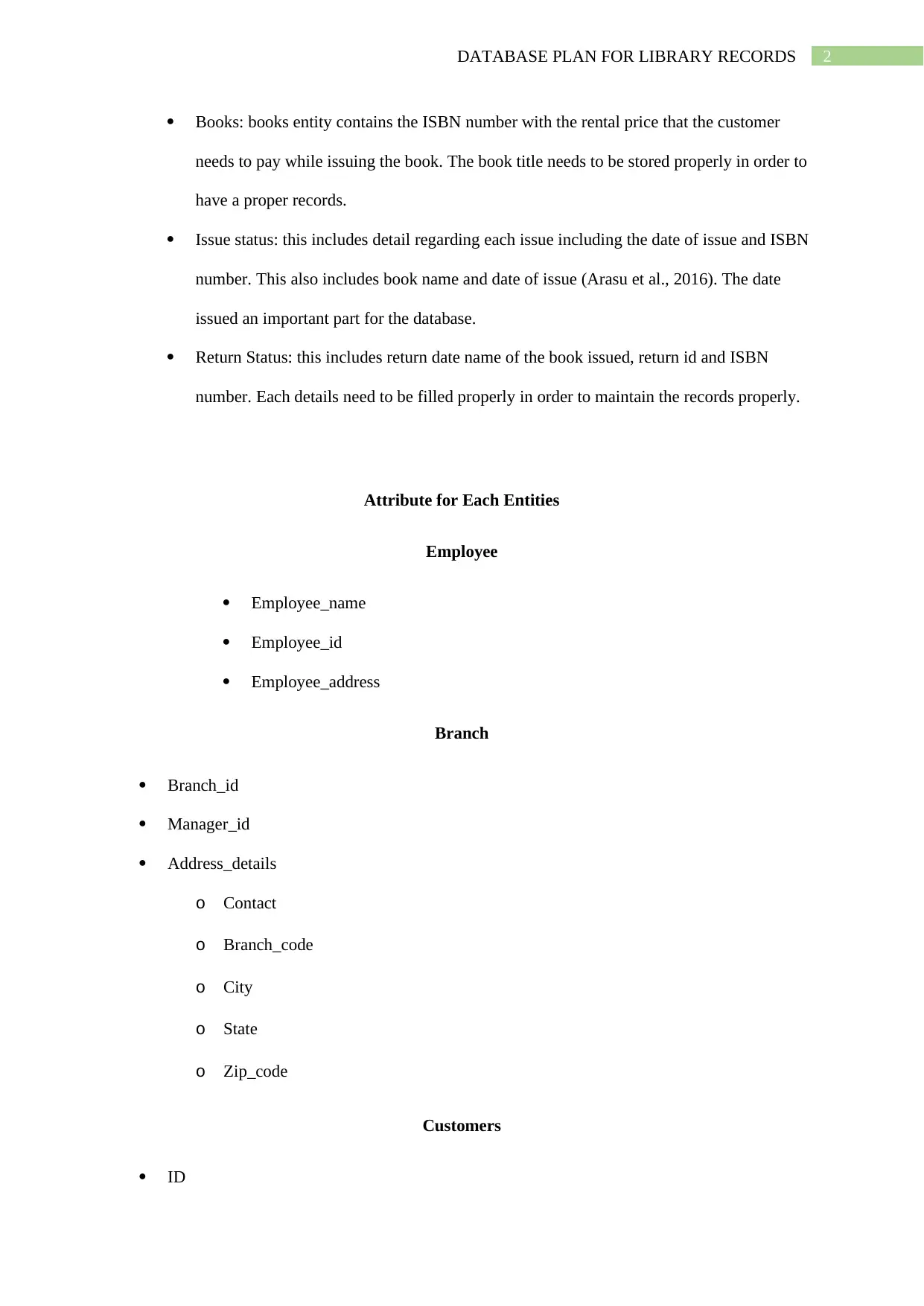
2DATABASE PLAN FOR LIBRARY RECORDS
Books: books entity contains the ISBN number with the rental price that the customer
needs to pay while issuing the book. The book title needs to be stored properly in order to
have a proper records.
Issue status: this includes detail regarding each issue including the date of issue and ISBN
number. This also includes book name and date of issue (Arasu et al., 2016). The date
issued an important part for the database.
Return Status: this includes return date name of the book issued, return id and ISBN
number. Each details need to be filled properly in order to maintain the records properly.
Attribute for Each Entities
Employee
Employee_name
Employee_id
Employee_address
Branch
Branch_id
Manager_id
Address_details
o Contact
o Branch_code
o City
o State
o Zip_code
Customers
ID
Books: books entity contains the ISBN number with the rental price that the customer
needs to pay while issuing the book. The book title needs to be stored properly in order to
have a proper records.
Issue status: this includes detail regarding each issue including the date of issue and ISBN
number. This also includes book name and date of issue (Arasu et al., 2016). The date
issued an important part for the database.
Return Status: this includes return date name of the book issued, return id and ISBN
number. Each details need to be filled properly in order to maintain the records properly.
Attribute for Each Entities
Employee
Employee_name
Employee_id
Employee_address
Branch
Branch_id
Manager_id
Address_details
o Contact
o Branch_code
o City
o State
o Zip_code
Customers
ID
⊘ This is a preview!⊘
Do you want full access?
Subscribe today to unlock all pages.

Trusted by 1+ million students worldwide
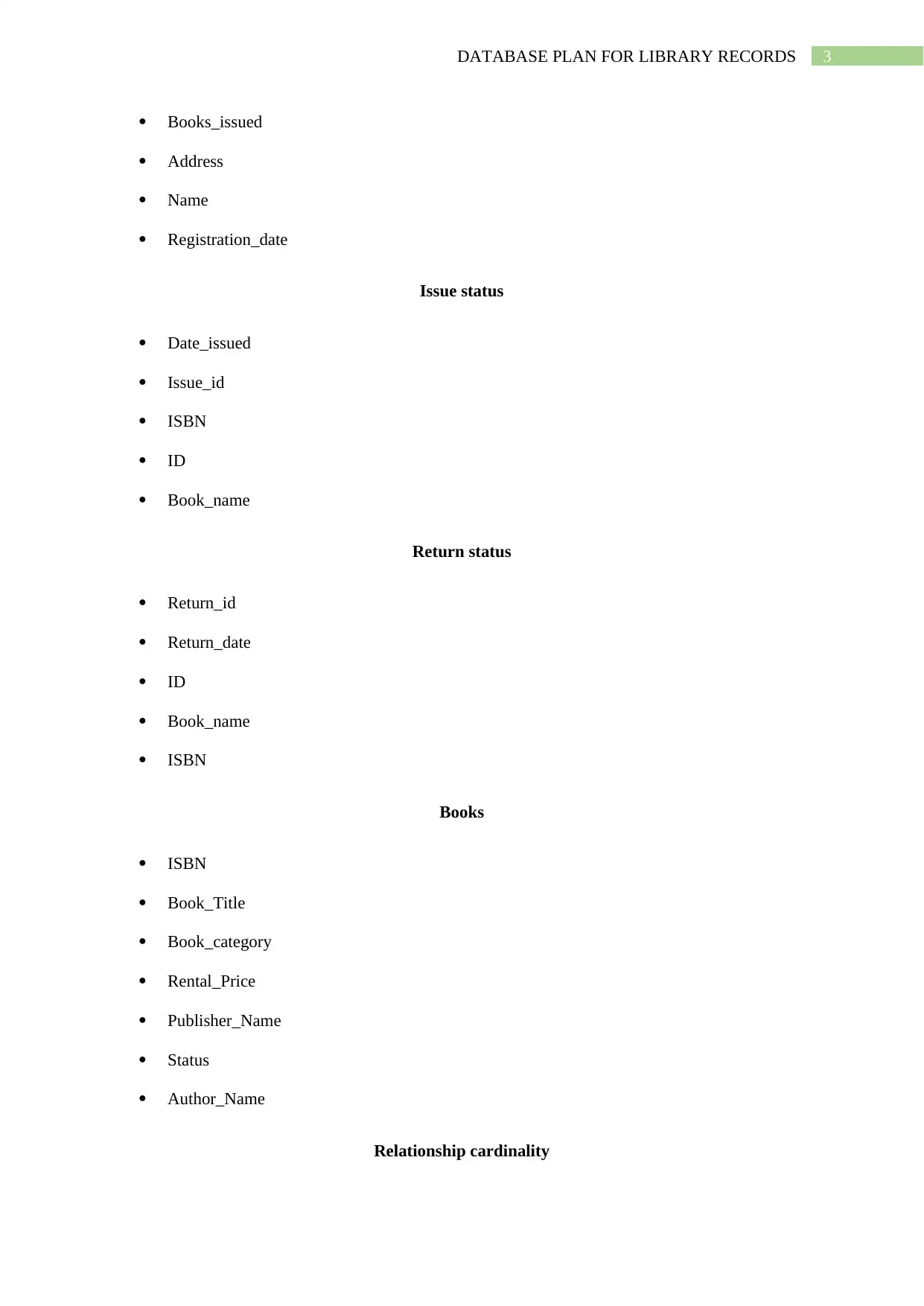
3DATABASE PLAN FOR LIBRARY RECORDS
Books_issued
Address
Name
Registration_date
Issue status
Date_issued
Issue_id
ISBN
ID
Book_name
Return status
Return_id
Return_date
ID
Book_name
ISBN
Books
ISBN
Book_Title
Book_category
Rental_Price
Publisher_Name
Status
Author_Name
Relationship cardinality
Books_issued
Address
Name
Registration_date
Issue status
Date_issued
Issue_id
ISBN
ID
Book_name
Return status
Return_id
Return_date
ID
Book_name
ISBN
Books
ISBN
Book_Title
Book_category
Rental_Price
Publisher_Name
Status
Author_Name
Relationship cardinality
Paraphrase This Document
Need a fresh take? Get an instant paraphrase of this document with our AI Paraphraser
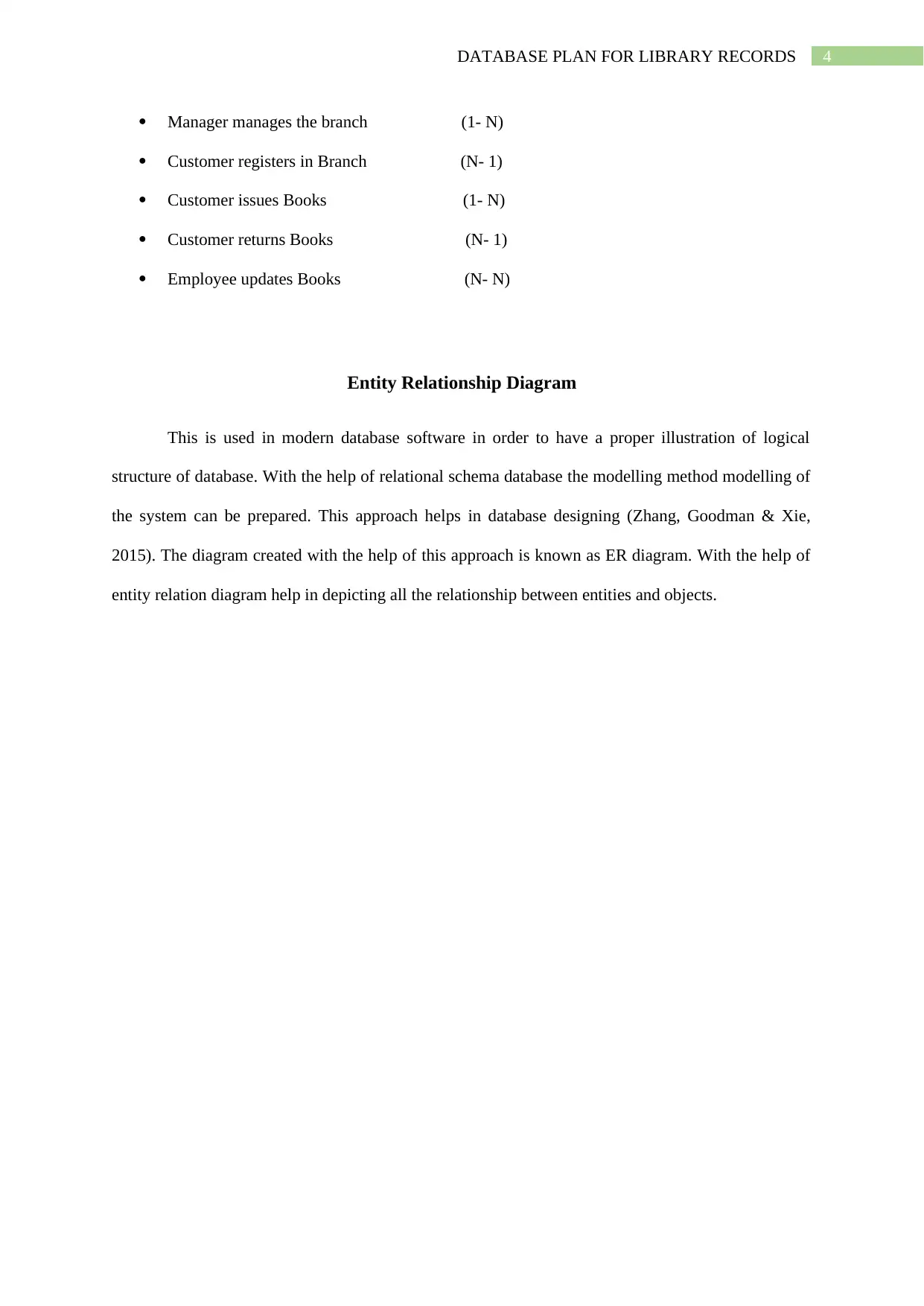
4DATABASE PLAN FOR LIBRARY RECORDS
Manager manages the branch (1- N)
Customer registers in Branch (N- 1)
Customer issues Books (1- N)
Customer returns Books (N- 1)
Employee updates Books (N- N)
Entity Relationship Diagram
This is used in modern database software in order to have a proper illustration of logical
structure of database. With the help of relational schema database the modelling method modelling of
the system can be prepared. This approach helps in database designing (Zhang, Goodman & Xie,
2015). The diagram created with the help of this approach is known as ER diagram. With the help of
entity relation diagram help in depicting all the relationship between entities and objects.
Manager manages the branch (1- N)
Customer registers in Branch (N- 1)
Customer issues Books (1- N)
Customer returns Books (N- 1)
Employee updates Books (N- N)
Entity Relationship Diagram
This is used in modern database software in order to have a proper illustration of logical
structure of database. With the help of relational schema database the modelling method modelling of
the system can be prepared. This approach helps in database designing (Zhang, Goodman & Xie,
2015). The diagram created with the help of this approach is known as ER diagram. With the help of
entity relation diagram help in depicting all the relationship between entities and objects.
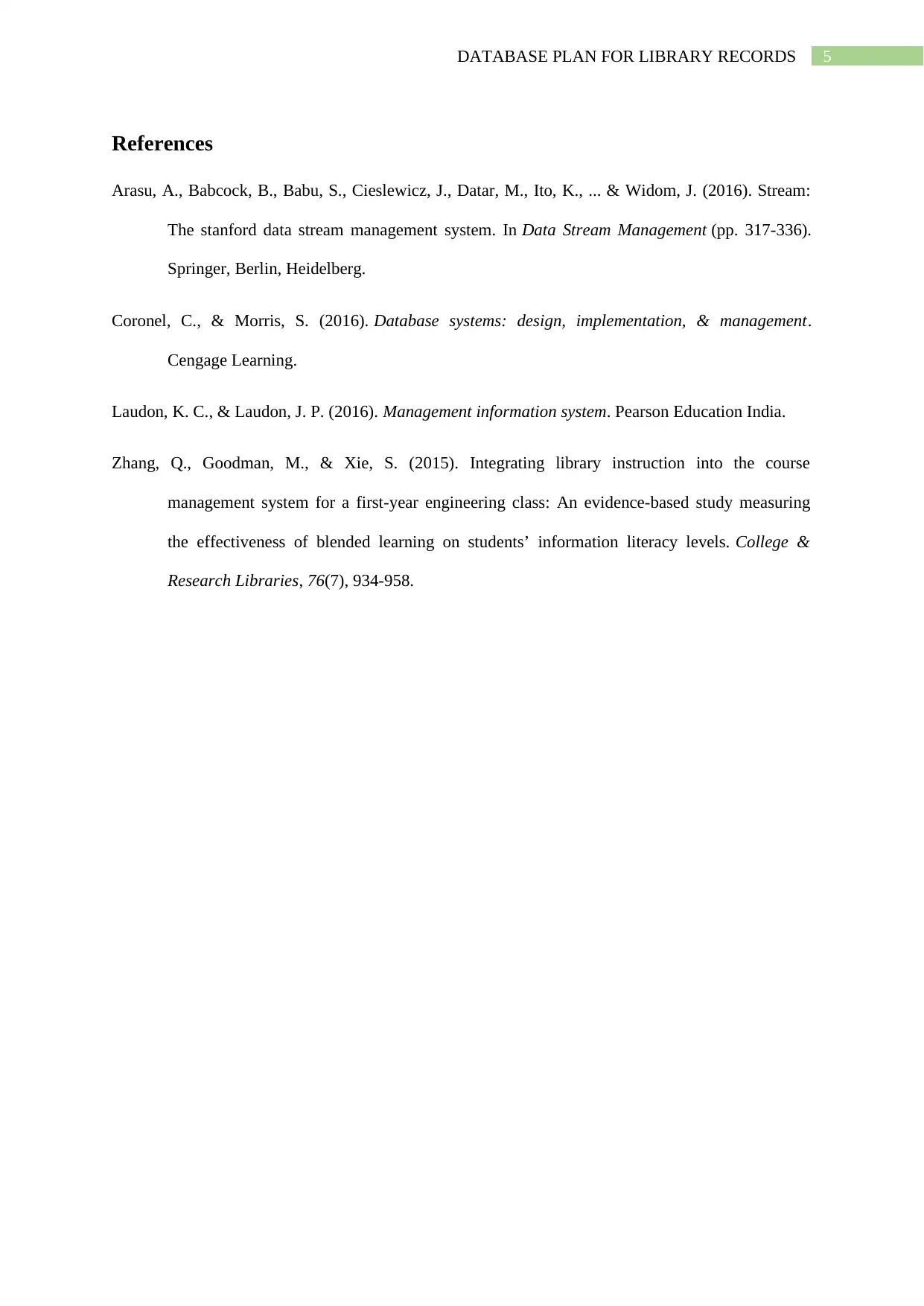
5DATABASE PLAN FOR LIBRARY RECORDS
References
Arasu, A., Babcock, B., Babu, S., Cieslewicz, J., Datar, M., Ito, K., ... & Widom, J. (2016). Stream:
The stanford data stream management system. In Data Stream Management (pp. 317-336).
Springer, Berlin, Heidelberg.
Coronel, C., & Morris, S. (2016). Database systems: design, implementation, & management.
Cengage Learning.
Laudon, K. C., & Laudon, J. P. (2016). Management information system. Pearson Education India.
Zhang, Q., Goodman, M., & Xie, S. (2015). Integrating library instruction into the course
management system for a first-year engineering class: An evidence-based study measuring
the effectiveness of blended learning on students’ information literacy levels. College &
Research Libraries, 76(7), 934-958.
References
Arasu, A., Babcock, B., Babu, S., Cieslewicz, J., Datar, M., Ito, K., ... & Widom, J. (2016). Stream:
The stanford data stream management system. In Data Stream Management (pp. 317-336).
Springer, Berlin, Heidelberg.
Coronel, C., & Morris, S. (2016). Database systems: design, implementation, & management.
Cengage Learning.
Laudon, K. C., & Laudon, J. P. (2016). Management information system. Pearson Education India.
Zhang, Q., Goodman, M., & Xie, S. (2015). Integrating library instruction into the course
management system for a first-year engineering class: An evidence-based study measuring
the effectiveness of blended learning on students’ information literacy levels. College &
Research Libraries, 76(7), 934-958.
⊘ This is a preview!⊘
Do you want full access?
Subscribe today to unlock all pages.

Trusted by 1+ million students worldwide
1 out of 6
Related Documents
Your All-in-One AI-Powered Toolkit for Academic Success.
+13062052269
info@desklib.com
Available 24*7 on WhatsApp / Email
![[object Object]](/_next/static/media/star-bottom.7253800d.svg)
Unlock your academic potential
Copyright © 2020–2025 A2Z Services. All Rights Reserved. Developed and managed by ZUCOL.





